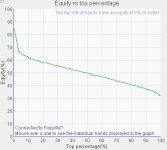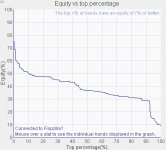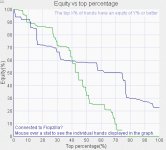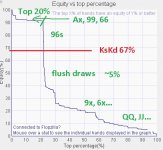I'm fine with poker homework. There's a reason I'm following a thread about the most complex math book to date. To crunch them numbers son!
Alright, there will be homework

BUT as we go deeper and deeper and I will be the only one posting examples/assignments/notes etc, I will need more time to come up with this stuff. It might seem surprising but I don't know everything

eek

and very often I need to watch some videos/read a book/experiment on my own etc before I post anything here (which is good ofc because it gives me an extra motivation but it also requires time).
Anyway, going back to those Equity Distribution graphs (there is an entire chapter in "
Expert Heads Up No Limit Holdem Volume 1" about this so if you find my explanation not sufficient, just grab that book). Basically, it's just a way of
showing how equity is distributed in a given range. Obviously, we can't just take AA and ask how much equity does it have because...that's hard to say (just like that)

Therefore, we need some point of reference - another range - that's why there are 2 lines on the graph. It works like this:
1. You specify two ranges (r1, r2); you can also pick a board.
2. For each hand combination in r1, you calculate its equity against range r2.
3. You sort all the hands in r1 by their calculated equities and than you just create a graph where:
Y-axis: Equity
X-axis: Hand Combinations (starting from the strongests)
4. You repeat steps: 2. and 3. for every hand in r2.
Those graphs are useful because:
a) they visualize your own range so you know how it looks like in any given spot (is it too strong/weak/capped/polarized/etc? if my strategy involves check-raising Top X% of my hands, what hands am I supposed to do this with etc).
b) they visualize opponent's ranges (can I thin-valuebet vs that range; how many bluffs does opponent have etc; it will be especially useful in River play).
c) they show range advantages: basically some boards/turns/rivers might favour different ranges (eg: A, K-high flops usually favour 3betting ranges, while Q,J-high flops favour 3bet calling ranges). We will look at that closely in another post (I already have an example prepared).
Graph 1: So the first cool graph is an
Equity Distribution of ATC vs ATC ranges. It looks like this:

It might look familiar to some people. Looking at the graph, the strongest hand has about 85% equity against ATC and those are...AA! Next are:
[AA (85.2%), KK, QQ, JJ, TT, 99, 88, AKs, 77, AQs, AJs, AKo, ATs, AQo, AJo, KQs, 66, A9s, ATo, KJs, A8s (61.9%)] -
those are Top 10% of all Holdem starting hands!
AKs actually has about 67% equity and after it,
the equity line declines fairly slowly and there are lots of hands close in equity (remember that there are 1326 combos in an ATC range and every combo has its "place" on the X-axis). The worst hand is 32o - it has 32.3% equity.
Graph 2: We've already talked about
made hands vs
draws. Let's say we have a board:
Ah9c6c and some 65% range.
What is a difference between KsKd (made hand) and 8c7c (draw)? They both are similar in their equities (67% and 61% vs 65% range)... but:
This is an Equity Distribution of 65% range vs KcKd (67% equity):
 And this is 65% range vs 8c7c (61% equity):
And this is 65% range vs 8c7c (61% equity):

Thoughts?

Btw, if you don't have a full version of Flopzilla, you can still get those graphs using a tool called
EDVis. It's free and I think I've already mentioned it.













